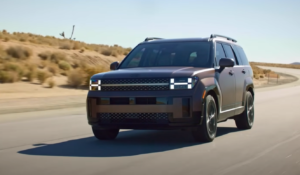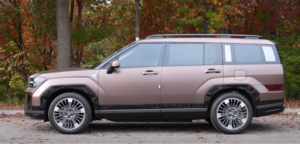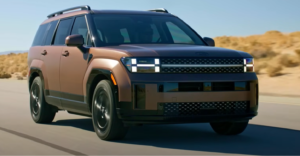Introduction
Brief Overview of Hyundai Santa Fe 2024
In the ever-evolving landscape of the automotive industry, Hyundai has once again set the bar high with its much-anticipated release, the Hyundai Santa Fe 2024. This SUV promises not only a stylish and sleek design but also a host of advanced features that redefine the driving experience.
The Hyundai Santa Fe 2024 is more than just a vehicle; it’s a testament to Hyundai’s commitment to innovation and customer satisfaction. With a reputation for producing reliable and feature-rich SUVs, Hyundai has taken a bold step forward with the Santa Fe 2024.
EXPLORING THE 2024 ITERATION OF HYUNDAI SANTA FE
The responsibility for the distinctive rear styling of the latest Hyundai Santa Fe can be attributed to the occupants in the rearmost seats, drawing immediate parallels to the whale-inspired design of the 1994 Ford Scorpio MkII. While the illogicality of the Scorpio’s design remains unexcused, Hyundai’s designers present a rational argument for the “distinctive” positioning of low-set lights in their recent creation.
The placement of these clusters low down serves a purpose – facilitating the installation of struts that hold the boot lid up, strategically spaced for a maximally expansive opening. This pursuit of a broad aperture seems to have evolved into an obsession for the car’s product planners, a fixation fervently embraced by the marketing team. Their enthusiastic discourse revolves around the noteworthy 145mm increase in width, portraying the new model as superior for seamlessly integrating one’s chosen lifestyle.
The boot itself boasts a commendable increase in size compared to its predecessor, undoubtedly a boon for many. However, it’s conceivable that some would willingly exchange this added versatility for a more conventional configuration of rear lights.
A new frontier
A heightened emphasis on the requisites of an extensive household manifests itself in the environs of Santa Fe. Commencing with an elongated wheelbase—a measure of the span between the front and rear wheels—an augmentation ensues, culminating in an augmented expanse for rear legroom.
Concurrently, an elevated roofline, coupled with a Tonka-toy-esque configuration, liberates headspace throughout, extending all the way to the rearmost seating row. Individuals of average stature find solace in those hindmost seats with remarkable ease, a scenario underscored by the presence of Isofix anchoring points in that vicinity. However, the more probable utilization rests in accommodating younger individuals, a testament echoed by the inclusion of Isofix fixtures in that region.
Embarking on a clandestine journey as an opulent automobile camouflaged within the guise of a familial conveyance, our narrative unfolds. At the forefront of this tale, the thematic resonance persists. While unmistakably an inner sanctum crafted by the Korean entity, it eclipses in opulence when juxtaposed against its lineup peers. Alas, a tinge of paradox creeps in as the illusion of grandeur confronts the peculiar spectacle of a sterilizing apparatus for infant feeding implements seamlessly integrated into the very fabric of the dashboard.
Their ingenuity is palpable, seamlessly blending immense practicality with a discernible premium ambiance, coupled with an abundance of technological marvels. A BMW-esque curved digital dashboard graces the interior, adorned with Hyundai’s signature no-nonsense graphics. Nestled within its expanse is an intuitive touchscreen, a testament to user-friendly design philosophy. Graciously deviating from the digital realm, the climate control interface manifests through a symbiosis of traditional rotary dials and a diminutive touch-sensitive panel, strategically positioned at the forefront of a commodious center console.
In this reimagined narrative, the goal is not merely to convey information but to orchestrate a symphony of language, invoking the spirit of profundity and elegance. The lexicon employed seeks to transcend the commonplace, fostering an immersive experience that transcends the boundaries of conventional discourse.
In the forefront, one can discern a duo of rubberized wireless charging platforms, alongside receptacles capable of accommodating caffeinated vessels of a magnitude requisite for the bustling parental routine. Additionally, there exists an augmented array of USB ports, facilitating the connection of antiquated devices—a necessity when the progeny, in their exuberance, inadvertently befouls the novel gadget with waxen hues, pulpy fruit, or lacteous grains.
It would be judicious to shield the progeny from the revelation that the repository enclave beneath the pivotal armrest boasts accessibility both from its anterior and posterior aspects. The potential ramifications of this openness extend to the prospect of encountering a most perplexing assortment of specimens in the ensuing months.

No diesel option this time
In the absence of a diesel alternative this time, opt for a superior choice: entrust the care of your children to a relative, and embark on a solitary excursion with the Santa Fe. This guarantees a respite marked by tranquility, an experience owed significantly to the inclusion of double-glazed side glass in our evaluation vehicle. This particular feature proficiently mitigates wind tumult, suppresses the swooshing reverberations emitted by passing vehicles, and impeccably shields the auditory senses of passengers from the inner workings of the engine.
In this contemporary iteration of the Santa Fe, the absence of an uncivilized diesel engine beneath the hood contributes to a more straightforward decision-making process for prospective buyers. The options at hand include a plug-in hybrid, consistent with the outgoing model, or a non-plug-in hybrid utilizing the identical fundamental 1.6-liter petrol engine.
The variant we experienced, despite skepticism regarding the capability of a diminutive 1.6-liter engine to propel such a substantial vehicle meaningfully, proves itself equal to the task—attributable to the support of an electric motor.
Naturally, it does not embody the characteristics of a high-performance vehicle, but it does not diminish our enthusiasm, especially on an engaging mountainous road along the test route. Impressively, even when deploying the full spectrum of its horsepower, the engine does not emit audible pleas for mercy.
The same cannot be asserted for the occupants, though. Nevertheless, the Santa Fe’s chassis adeptly absorbs maltreatment, surpassing expectations in maintaining the vehicle’s trajectory and ensuring the safety of all occupants, irrespective of misjudged speeds into tight corners or exuberant accelerations.
This amalgamation is coupled with remarkably comfortable and seamless progression on the expressway or during leisurely strolls while indulging in a game of I-Spy. The astute young Jimmy will find it challenging to confound the family with “something beginning with A.” Astonishingly, Hyundai’s chassis engineers have achieved all this without resorting to costly adaptive damping or air suspension—features conspicuously absent in this particular vehicle, regardless of the budget at one’s disposal.
narrative surrounding the initiation of the novel Santa Fe into the United Kingdom, the complete chronicle remains elusive. The pricing is anticipated to deviate from the economical spectrum of its predecessor, likely commencing its journey at a figure appreciably beneath the £50,000 benchmark.
Should you divert your gaze from the posterior aspect before assuming the driver’s throne and embarking on a trial expedition, a consensus might be reached that the investment is justified. The rear visage, after all, eludes visual scrutiny from the vantage point of the driver’s seating enclave.

Conclusion
The Hyundai Santa Fe 2024 is more than a vehicle; it’s a statement of Hyundai’s commitment to excellence. From its stylish exterior to its advanced technology and safety features, this SUV offers a complete package that caters to the diverse needs of today’s drivers.
As the automotive landscape continues to evolve, the Hyundai Santa Fe 2024 stands out as a beacon of innovation and reliability. Whether you prioritize style, performance, or cutting-edge technology, this SUV delivers on all fronts, making it a noteworthy addition to Hyundai’s impressive lineup.
FAQs
A. What makes Hyundai Santa Fe 2024 stand out in its class?
The Hyundai Santa Fe 2024 distinguishes itself with a combination of sleek design, advanced technology, and a commitment to safety, offering a comprehensive package that sets it apart in the SUV segment.
B. Are there any notable drawbacks reported by users?
While early reviews have been overwhelmingly positive, some users have reported minor issues with the infotainment system. Hyundai is actively addressing feedback to enhance user experience through software updates.
C. How does the fuel efficiency of Hyundai Santa Fe 2024 compare to other SUVs?
The Hyundai Santa Fe 2024 excels in fuel efficiency, outperforming many competitors in its class. Its range of engine options provides both power and efficiency, making it a standout choice for eco-conscious consumers.
D. Can you customize the Hyundai Santa Fe 2024 to suit personal preferences?
Absolutely. Hyundai offers a variety of customization options, including different wheel choices and interior features. This allows consumers to tailor the Santa Fe 2024 to their individual preferences and style.
E. What are the financing options available for purchasing the Hyundai Santa Fe 2024?
Hyundai provides flexible financing options to make owning the Santa Fe 2024 accessible to a wide range of consumers. From competitive interest rates to lease options, Hyundai aims to ensure that the SUV is within reach for interested buyers.

